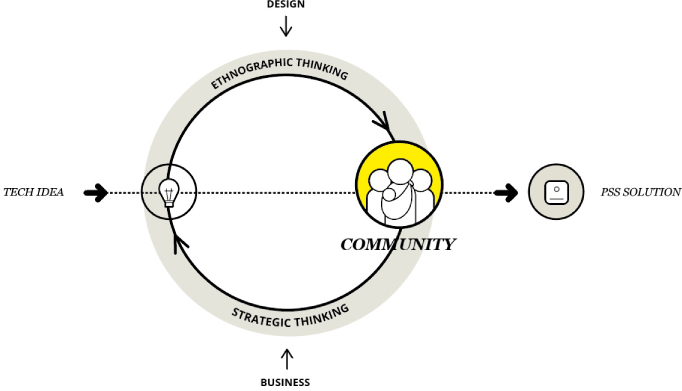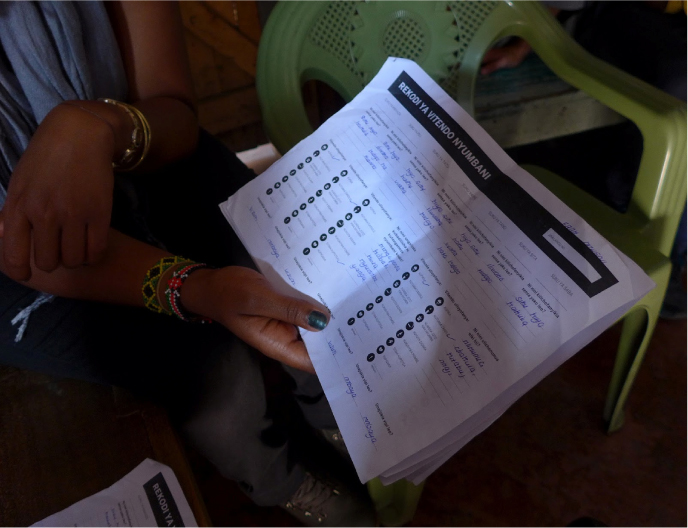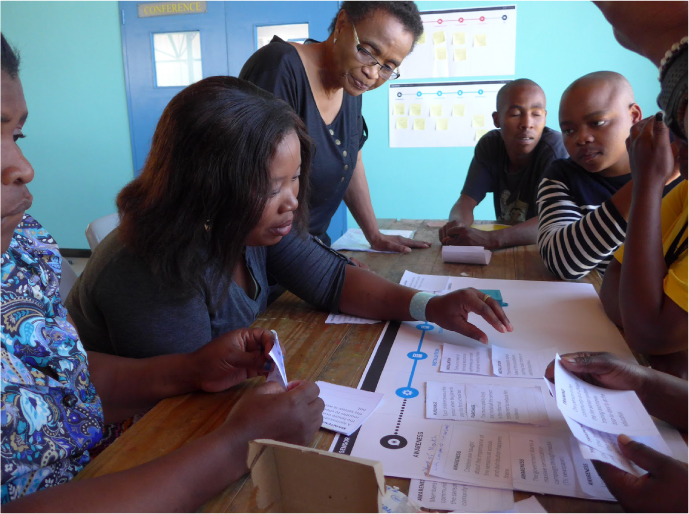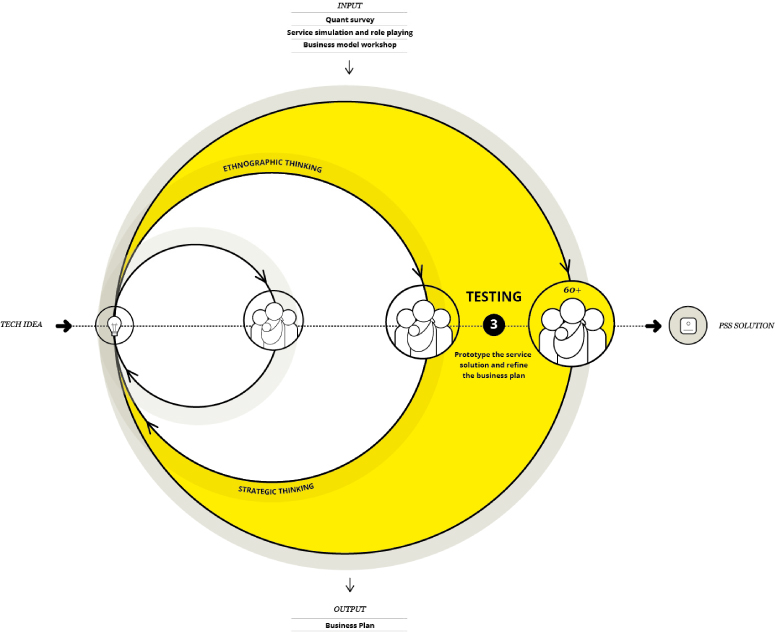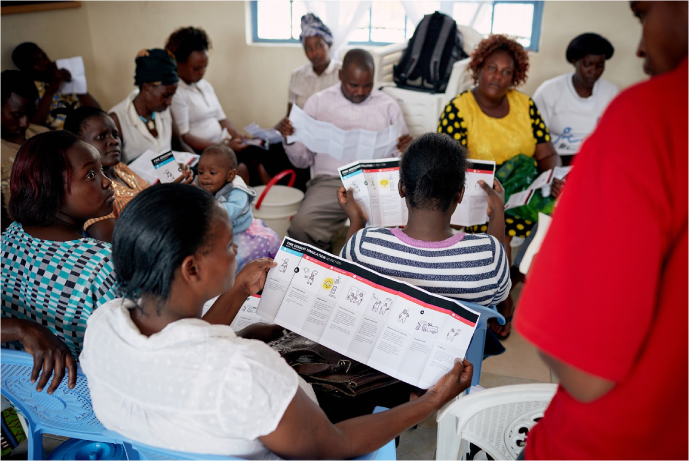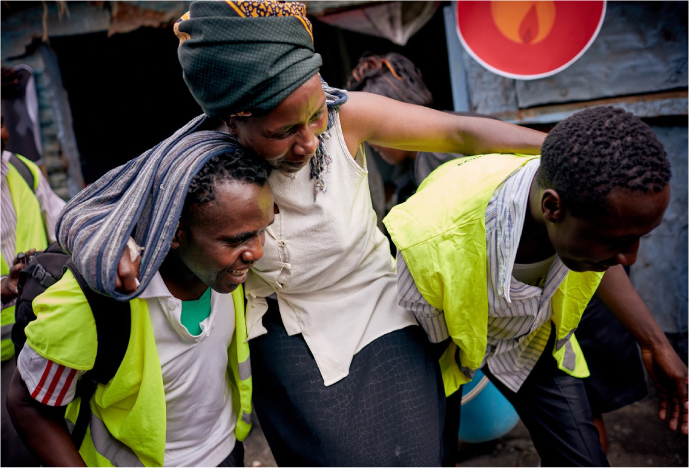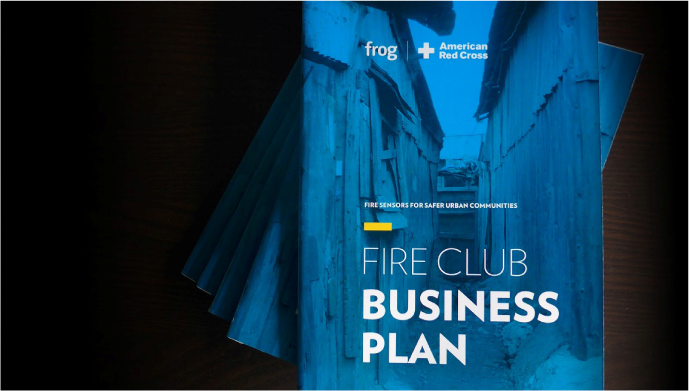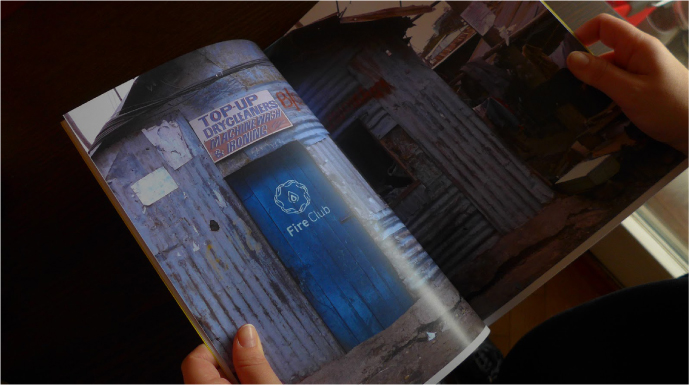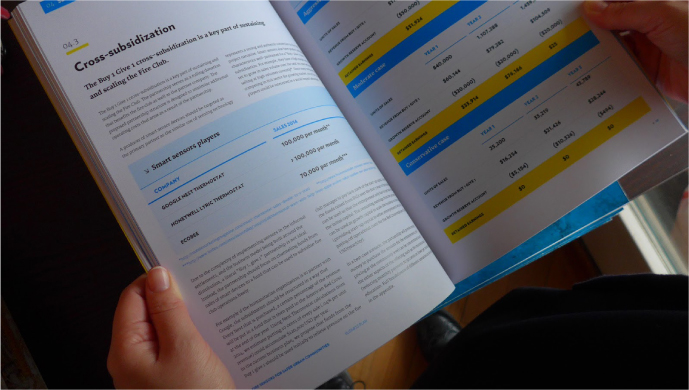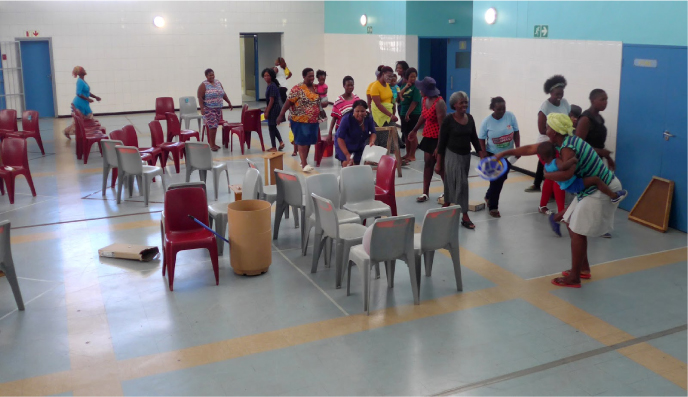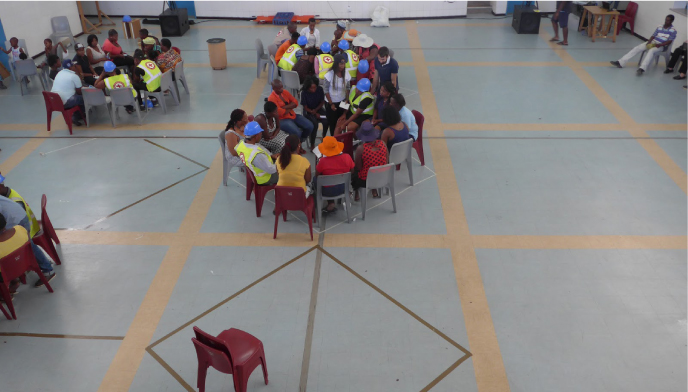Emerging technologies such as drones, sensors, mesh networks and IoT have significant potential to bring new life-changing services and benefits to places where infrastructure and ICT access is still limited. Nevertheless, many companies have already failed in the attempt to bring new solutions to the underserved population in emerging markets due to gaps in understanding capability and lack of systemic approach.
ICT interventions are often market creation scenarios that require completely new behaviors for adoption (Simanis et al, 2010). The creation of these behaviors, from introduction, to sensemaking and usage, can benefit from deep ethnographic analysis not only to assess people’s capability (Sen, 1985), met and unmet user needs (Martin et al., 2006) and product requirements, but also to frame the best service design strategy including critical elements such as distribution channels, business model and maintenance processes. The tools and methods that purely belong to ethnographic research (Beyer, Holtzblatt, 1998) need to embrace the business and strategy dimension, combining the two approaches to outline a successful implementation path.
ICT interventions are also systemic, grounded in a multiplicity of existing roles and group dynamics that participate to the implementation and delivery of the new product or service (Kirsch, Bildner, Walker, 2016). Therefore, in informal economies, targeting significant behavior and system changes requires a strong iterative work with the local communities, as primary partner in defining and adopting the final solution (Simanis et al., 2008). The engagement of the community becomes central, turning the whole design and strategy process into a continuous dialogue between the experts and the local residents.
The purpose of this paper is to describe a combined design ethnography and business strategy approach towards a more efficient design of emerging technology interventions in informal economies. The “For us by us” model – sbuilt upon the BoP 2.0 framework (Simanis et al., 2008) and tailored ethnographic and co-creation techniques (Sanders, Stappers, 2007) – is a chance for practitioners and organisations who are investigating potential technology-based interventions to quickly evaluate, prioritize and develop products and services that add value to people’s lives, and have an increased probability of successful adoption.
INTRODUCTION
Technology is only as powerful as it is accessible. (Hector Ruiz, 2008)
The idea for the For us by us model presented in this paper was formed while working on a specific IoT-based solution as part of the Fire Sensors for Safer Urban Communities project promoted by the American Red Cross in collaboration with the South African Red Cross Society, the Kenyan Red Cross Society and the communities of Khayelitsha (Cape Town) and Mukuru (Nairobi)1.
Figure 1. Community members of Mukuru (Nairobi) during the Fire Sensors for Safer Urban Communities project (December 2015). Photo by Juozas Cernius, American Red Cross.
The rapidly increasing populations in informal settlements in Sub-Saharan Africa has lead to urban structures prone to sudden and destructive fires, caused by cooking with open flames indoors, burning trash, overextending faulty wires or trying to heat the shacks. Due to the density of those settlements, fires spread quickly and often cause large-scale physical and human damage that increase poverty in those communities. The humanitarian organization identified the opportunity to address the challenge through the use of sensors and hypothesized: what if our organization could distribute cheap fire sensors to slum residents to help decreasing the incidence and tragic consequences of fire episodes? In developing an approach to piloting the technology, they established a partnership with a start-up2 in South Africa working on networked fire sensors for such a context, and also partnered with a smart sensor producer in the US to develop an alternative product.
The fire sensors were specifically designed for the informal settlements to detect heat instead of smoke, and to be networked together to alert other community members of a potential fire that could spread. The hypothesis came along with another significant challenge: how can we implement and distribute this fire safety solution at large scale?
The humanitarian organisation was interested in a self-funding mechanism that could cover costs and scale the intervention to make a broader impact without relying on continuing donations. This required the development of a clear marketing strategy to introduce the new product in that context that would create new demand and a self-sustaining business model.
The concept of cheap fire sensors installed inside every shack seemed to be a promising solution based on an initial investigation with the local residents where the issue of fire was identified as a top concern for the community, and it was hypothesized that an early alert system could enable the community to locate and handle fires in their initial stage (similarly to the functioning of regular smoke detectors in formal houses). However, the idea of distributing those sensors was significantly challenged by the residents’ mental models about fire prevention and response, as well as by community dynamics and overall expenditure habits. Mental models of dealing with fire have never included the use of a physical siren, and the interaction of a networked system of sensors had very little precedence in the minds of users. Introducing an alert system would have required residents to take responsibility and ownership of the solution, understand how the detectors work (e.g. place them in the right position inside the shack) and maintain them over time (e.g. avoid using the sensors’ batteries for other devices). The density of population in the informal settlements can quickly turn a single fire into a community-wide disaster, and thus fire prevention has a significant social dynamic in discussions and action (e.g. in some communities the resident/s who start the fire are persecuted). Different population groups may play different roles in the fire journey (children vs adults, women vs men, house tenants vs landlord, rescuers vs thieves, temporary vs permanent dwellers), and their interests in saving (or not saving) their house and belongings vary. Since residents were not accustomed to the idea of spending money to reduce the risk of fire, the plausibility of creating new space in the consumer’s budget would need to be researched. These, among other challenges, were the starting point for our exploration, and led to the consolidation of the approach that we want to propose and discuss in this paper: a combined ethnographic thinking and business strategy process designed around community engagement as a way to make a tech-based innovation available and impactful in slum economies.
The paper explores the topic of emerging technologies for emerging consumers by describing:
- The opportunity
- The challenges
- The For us by us model
- The Fire Club case study
EMERGING TECHNOLOGIES FOR EMERGING CONSUMERS: THE OPPORTUNITY
In Africa sometimes you can leapfrog and go to the latest in innovation and technology at the same time. (GSMA)3
Emerging technology has the potential to address a variety of challenges and nearly endless practical applications4, playing a powerful role in enhancing quality of life and supporting future development in a context where infrastructure is at the bare minimum.
We have already seen how, in a few years, the proliferation of mobile networks has transformed communications in sub-Saharan Africa, allowing Africans to skip the landline stage of development and jump right to the digital age. Mobile devices opened huge opportunities to reach the underserved world population with new services, filling significant gaps in healthcare, education and financial systems. M-Pesa, in Kenya, has given many unbanked people increased financial access, and enabled transactions that were previously impossible – such as sending money from the centre of Nairobi to a relative living further away in the rural areas. The transaction value handled by mobile money solutions in the continent is predicted to top $160 billion by 2016, significantly more than the value handled in Europe and North America5.
A wide range of tech initiatives, such as M-Kopa Solar Energy in Kenya6, Zipline’s drone delivery of blood in Rwanda7 and Vodaphone’s implementation of M2M security services in South Africa8 show how emerging technology is revolutionising every sector, opening up new opportunities for emerging consumers to access life-changing services and encouraging practitioners to re-examine old models.
This is just the beginning of a clear growth potential, often identified as the second wave of digital revolution in SSA and associated with the rise of IoT to provide vital services. However, technology is just a single component when it comes to implementing and delivering IoT based solutions. There is a whole level of logistics channels, supply chain and customer service that needs to be created which must overcome the infrastructure barriers that are still part of the context and can determine the success of failure of those initiatives.
Market-driven approaches towards alleviating poverty have shown promise in previous theoretical frameworks such as Prahlahad’s Base of the Pyramid, which posited that re-designing business models for the specific demographic conditions of the world’s poor (low price point, high volume approach with redesigned products) can reduce poverty and provide a commercially attractive opportunity for the company. Although BoP business models have struggled to maintain commercial success anticipated by early scholars often due to difficulty in creating effective channels to market and keeping operational expenses under control (Simanis, 2012), the aforementioned advancements in mobile money, connectivity, and infrastructure provide ways to overcome some of the issues that affected previous success. At the same time, using increasingly advanced technology comes with new challenges, which were not prevalent in previous market driven approaches to development focused on micro-portioning consumer goods like laundry detergent through traditional channels that people were already familiar with (e.g. informal grocery stores).
This paper builds on past challenges of BoP approaches by applying the fundamental principles in the context of a more connected and tech-friendly developing economy.
EMERGING TECHNOLOGIES FOR EMERGING CONSUMERS: THE CHALLENGES
The main challenge is to give voice to the low-income population, keeping their perspective from fieldwork investigation until the definition of final strategies. (Luciana Aguiar)9
Reaching emerging consumers with technology services raises complex business and design challenges around (1) consumer mental models, (2) dynamic cost structures, (3) distribution channels, and (4) the need of applying an iterative product development process.
- Companies struggle defining the clear value proposition for new technology that resonate with the needs, behaviors and mental models of emerging consumers. Mental models are defined as a user’s beliefs about a system such as a new computer, or a risk reduction service such as an insurance policy. The beliefs that make up a mental model are heavily influenced by a user’s conceptualization of themselves and the environment that surrounds them. In complex operating environments such as urban slums, common assumptions are fundamentally challenged.
- ICT interventions require dynamic cost structures that change over time to account for ongoing network costs, data and maintenance. Innovative business models that shift from a one-time transaction to a relational approach that extracts customer value over time can create opportunities for sustainability (Porter, Heppelman 2015). However, exploring this kind of business model innovation in complex operating environments such as urban slums must address difficult questions around volatile cash flows of residents and irregularities in their budgeting process.10
- The failure to establish effective distribution channels for products in the local context has historically been a weak point in previous BoP approaches (Chikweche, Fletcher, 2011). Ecosystems through which channels must pass are de-stabilized by factors such as poor infrastructure and suffer from a lack of collaboration and competition. The instability of these channels (Anderson, Markides, Kupp, 2010) increases the operational expenses of the BoP enterprise, and damages commercial sustainability. Deep ethnographic analysis should be applied to the wider ecosystem as it helps develop a deep understanding of the key players, operational environment and other factors that shape it (Kirsch, Bildner, Walker, 2016), and how they may come together to form an effective channel to market.
- Innovation cycles targeting BoP markets require an iterative and inclusive process that generally involve a high level of uncertainty in defining the investment profile, partnership structure, user needs and value proposition (Chevrollier, De Vogel, 2013). Stage-gate product development processes at the base of the pyramid share a similar narrative that deep user empathy and co-creation informed the product and service definition, but failed in the market place. Current academic literature expresses that there is space to examine the blurring and iterativeness of product design and delivery cycles (Viswanathan, Sridharan, 2012) to simultaneously ensure relevance and affordability of the solution for the target users while addressing dependencies and business needs across the operating reality. Our literature review also revealed that the detailed investigation of distribution management issues is underexposed (Reiner, Gold, Hahn, 2015) and organisations struggle to grow a new business model within the existing business (Reficco, Gutiérrez, 2016).
Our hypothesis, introduced in the next section, is that existing innovation frameworks (Halme, Kourula, 2015) could be evolved by better weaving together business and ethnographic thinking across the iterative development cycles to increase the chances that the emerging business will reach the desired outcomes and that the emerging business will cooperate alongside the legacy business.
THE “FOR US BY US” PRODUCT-SERVICE SYSTEM DEVELOPMENT CYCLE: COMBINING DESIGN ETHNOGRAPHIC AND STRATEGIC THINKING TO DRIVE TECH INNOVATION IN EMERGING ECONOMIES
For us by us. (Lumka)11
Figure 2. For us by us high-level framework, by Roberta Tassi.
The goal of the For us by us model is to provide a framework for the development of ICT interventions that allows to quickly move from a tech-based opportunity –identified by either international or local businesses and individuals- to a complete Product-Service System solution ready for a scalable and sustainable implementation.
Given the mix of expertise demanded by challenges listed in the previous chapter, development of ICT interventions benefit from a collaborative approach between ethnography and business strategy. Specific ethnographic and strategic thinking tools need to guide the activity of service and business modelling, in a continuous dialogue with the individuals and the groups that will be the final recipients of the solution (Darrouzet, Wild, Wilkinson, 2010; Halme, Kourula, 2015; Powell, 2015). We introduce the For us by us innovation cycle as a paradigm for applying this type of approach towards ICT product design within operationally complex environments such as urban slums. The model suggests:
- The creation of a dedicated ethnographic/strategic thinking toolkit for emerging economies to support the simultaneous definition of value proposition, service system and business model. New technology has always required the analysis and envisioning of new behaviors for market creation through ethnography (Grundin, 1990). Design thinking and human-centered design methodologies (Krippendorff, 1989; Brown 2008) have already demonstrated value in addressing innovation challenges in poor environments. From the first HCD toolkit for social impact projects published by IDEO (2009), to frog’s Collective Action Toolkit (2012, 2016) and the most recent mAgri Design toolkit (2016), the idea of applying user-centered design and design ethnography techniques to tackle systemic challenges in critical contexts has been widely explored. In the For us by us model, the ethnographic thinking toolkit is enriched with business strategy tools to support a continuous iteration between research and service or business design decisions. The combined toolkit stretches ethnographic methods to better assess business aspects, and vice versa, shifts techniques inspired by traditional consumer research to assess community interactions, motivations and behaviors.
- The adoption of community engagement to enable a constant virtuous exchange between the organization and the communities themselves, that participate to the definition of the final solution. The inclusive dimension is considered a key opportunity to solve all the previously stated BoP challenges and lead to relevant and affordable innovation (Chevrollier, De Vogel, 2013). Community engagement helps consolidate a meaningful and sustainable systemic solution, while raising awareness and readiness to embrace it (Hart, Milstein, 2006). The community is empowered to actively contribute to the product-service development cycle across every stage, by setting up dedicated activities in the environment where those communities live, and continuously generating insights that are immediately elaborated into proposals to be played back to the community. The For us by us model defines three ideal steps for community engagement, together with a set of exercises and rules to effectively move from initial exploration to the co-created solution.
Figure 3. For us by us product-service system development cycle, by Roberta Tassi.
This fully integrated in-field approach can quickly move from (1) learning from the community, informing business decisions by disclosing mental models and behaviours, to (2) designing with the community, ideating around aspects such as value proposition, distribution strategies and service delivery, and ultimately (3) testing with the community, simulating key service components and validating the final business model.
Learning with the Community
The learning phase aims to develop an in-depth understanding of the emerging consumers and create a set of design principles and high-level strategic scenarios for the product service system that are then taken into the Design phase as the frame of reference for the rest of the project. This section will discuss the goals and core components of the learning phase, followed by examples of practical application during the Fire Sensors for Safer Urban Communities Project.
Figure 4. Learning with the community: objective, input and output – For us by us product-service system development cycle, by Roberta Tassi.
The complexity of introducing tech services to emerging consumers demands a deep ecosystem analysis to establish the foundation for the service model (Kacou, 2010; Kirsch, Bildner, Walker, 2016). The goal of the learning phase, therefore, is to understand the emerging consumers’ mental models and behaviours, to define user priorities, estimate potential market demand, and hypothesize business model structure. The learning phase requires to zoom out of the context that surrounds the initial idea to find answers to the most uncomfortable questions – such as: “Do the fire sensor really matters to slum residents?”. A mix of contextual observation methods including (1) individual in-depth interviews and risk perception games, (2) diary studies, (3) expert and intercept interviews are combined with ecosystem mapping and market analysis, allowing the team to to come up with the desired answers.
- In this phase it’s important to reach out to single individuals to have extensive in-depth interviews that cover all the relevant habits, mindsets and behaviors in depth (Blomberg et al., 1993). The interview is structured as a 2-hour conversation, complemented with interactive shadowing before and after (Agar, 1996), and supported by dedicated hands-on games or activities. The interviews should target residents (inside and outside the communities that have been selected to be part of the development process) and other relevant actors that could participate to the product-service manufacturing, distribution and delivery (inside and outside the environment where the communities live). The conversations must zoom out to focus on the wider problem area that inspires the technology in order to explore the hypothetical value proposition. In the case of the fire sensors, this meant positioning the conversation with potential consumers around personal and property risk overall rather than focusing on fire immediately. Using physical exercises like the risk perception game allowed to gain deeper insights on the extent to which fire is a concern, and explore how potential users currently think of prevention, in order to carefully understand potential demand. The risk perception game is built as a card sorting exercise, where the participant is asked to go through a set of cards representing specific risks (e.g. violence, rubbery, flooding, fire, etc.) and position the ones they feel more scared of or affected by next to them, and the ones they feel not relevant further away. When the mapping is complete, the researcher can discuss each card positioning, exploring motivations, beliefs and mental models in depth. This game (and other similar card sorting or mapping exercises that could be designed according to the specific research purpose) help the participants reflecting on their behavior while discussing, and starting conversations about sensitive topics (e.g. sexual assault and crimes of passion as potential risks).
Risk perception game: example of an ethnographic/strategic insight –If I pour a glass of water, and it smells, I know that it is foul, but I still drink it, because I am thirsty. (James)12
Life in informal settlements is surrounded by risks everyday: especially theft and violence, which create significantly more pressure on a daily basis than other problems. Individual attention is thus concentrated on the short-term rather than proactively seeking real long-term solutions. We found that, considering the mindset and the low probability of fire affecting your life (18% in the next ten years, Cape Town Fire Dept data 2010-2015), buying a very cheap fire sensor as a private good in that context is like purchasing an unaffordable luxury: something you wouldn’t consider doing. The hypothesis of a business-to-individual consumer model through existing retail channels was ruled out. On a product strategy level, the fire sensor device would need to be enhanced to provide value on day 1, and needed to provide a more significant reduction of risk beyond just detection.
Figure 5-6. Conducting home visits, in-depth interview and risk perception game in Cape Town (October 2015). Photo by Roberta Tassi.
- In the learning phase, it’s also important to analyze the broader market ecosystem, developing empathy with all market players to estimate their potential participation in an eventual business model. Expert and intercept interviews are good techniques to get to know the broader spectrum of players, inside and outside the informal settlement, while optimizing the time spent in the field.
Intercept interviews: example of an ethnographic/strategic insight –Fires often start as arsons, for many reasons. One could be that the tenants are not paying the rent, and fire is the easiest way for the landlord to make them run away, rebuild the shacks and find replacements. (KK Security Employee)13
One of the assumptions was that landlords could be a good channel for the implementation of the fire sensor system, being interested in protecting their properties (similarly to how Sanergy14 implemented their sanitation service). Several stories collected through intercepts in the slum or experts from the fire brigade, disaster management department and micro-insurance providers revealed that the variability of landlord reliability made them a poor channel for a sustainable business model. Installing a sensor in the house should be backed by a conscious act of taking responsibility against the problem in order to increase probability of sustaining the technology and proper response activity.
- Install the technology (even if just a prototype) and run observational studies, like a small diary study, to understand how people perceive and react to the product in their everyday life. This can reveal crucial insights, that shape requirements at a product and system level.
Diary study: example of an ethnographic/strategic insight –My device has never worked; I would like to get a new sensor!
(Community member, Mukuru)Through the pilot installation and diary studies, we understood that regardless all the effort put in explaining the concept of the fire sensors through community demonstrations, individual training sessions and collaborative workshops, a lot of participants were still having troubles understanding the device and how it was supposed to work. The aspect of education (around fire safety and the sensor) emerged as a key aspect to be considered in shaping the service model and business plan. We needed to start thinking of local specialists that could answer questions at anytime and be fully responsible for the system maintenance, and how this could be economically sustained.
Figures 7-8. Sensor installation and 1-week diary study discussion in Nairobi (November 2015). Photos by Juozas Cernius, American Red Cross, and Roberta Tassi.
The outcome of the learning phase is a strategic positioning document that captures dynamics of needs while putting them into the frame of an economic utility analysis: from human archetypes and behavioural mapping, to an estimated size of the potential demand and market attractiveness in different business scenarios. Weaving the insights into these scenarios helped make the connection between the words of the community, and the practical decisions needed from a management perspective.
Designing with the Community
Designing with the community focuses on generating ideas and evaluating alternatives alongside local community members by iteratively building on the previous phase in order to give form to the service system and business model. Aspects of the system that can be co-designed at this stage include: manufacturing and distribution strategy, value proposition, consumer awareness, education and training, installation and maintenance of the solutions. This section will begin with a description of the core activities of the design phase and then describe the ethnographic and strategic tools used and the outcomes of the application on the fire sensors project.

Figure 9. Designing with the community: objective, input and output – For us by us product-service system development cycle, by Roberta Tassi.
The community workshops are the central activity of the designing phase, and apply a various set of co-design activities to arrive at the ideal service model and specific attribute values for key marketing decisions, such as value proposition, distribution strategies, service delivery, and pricing. These workshops are designed to embrace the of environmental complications such as low-literacy and social biases. These workshops have the ambition to sort all the service and marketing elements below and above the line of visibility, helping the community members evaluate alternatives, make decisions and shape the ideal system from their point of view. The design of the community workshops can be tailored to the specific project purpose and set-up, however, we recommend considering the (1) product future advertising exercise and the (2) experience journey mapping as key assets to help community members discuss and develop their own solutions.
- The product future advertising –inspired by the tomorrow’s headlines15 and service poster tools16– is an insightful way to understand the value the community recognizes in a product/service idea, and how they would talk and describe it to their peers. By making the workshop participants work in teams, you can ask them to come up with a name for that product/service, draw an image that would represent and advertise its core value, create a catchy statement and a final call to action (which can include the desired price/service mix). The easy building blocks and instructions allow them to quickly discuss and draw together, until the advertising poster is complete. The exercise is aimed at help community members explain the key benefits the solution would bring to their life (if any), and so assess the value proposition of the designed product-service system.
Product future advertising: example of an ethnographic/strategic insight –You should get a sensor for you, because I’ve already got mine!
(Community member, Khayelitsha)Besides the weak interest in buying a sensor expressed by single individuals during the in-depth interviews (due to the short-term planning explained in the learning by the community section), the future advertising exercise started to provide insights on how the system was positively perceived at the community scale and could be adopted as an infrastructure for the safety in the neighbor. In the advertising posters, many of the drawings were showing people coming together to fight the fire or the sensor as an angel protecting the community, and the messages were often referring to the idea of a common choice, a sense of pride of becoming advocates for a better quality of life in their neighbor, pointing to the community leader as the main ambassador. The idea of a business-to-community gained credibility as a solid opportunity, proposing the fire sensors as a safety solution that each member of the village could contribute towards, because of a shared intent of taking action against of the problem of fire.
Figure 10. Product Future Advertising exercise during the community workshop in Cape Town (November 2015). Photo by Roberta Tassi.
- From aspirations to solutions: after the future advertising exercise, the co-design workshops move in a detailed experience journey mapping exercise to support focused conversations around technical aspects such as distribution, purchase, installation, use and maintenance of the solution. The key journey steps can be displayed on a linear temporal axis, and detailed hypothesis can be evaluated to define what works better. As facilitators, you can use either drawings or texts on small cards, and encourage participants to either pick their favorites for each phase or come up with their own ideas (if not represented by any of the original hypothesis). It is important to structure the activities so that the community members are able to see and analyze every single aspect at-a-time, to slowly compose the big picture, and finally look at the service system and offering as a whole, and have conversations around it.
Experience journey mapping: example of an ethnographic/strategic insight –We don’t want to rely on external engineers to come and fix the sensors, the technician should be in the community. (Community member, Khayelitsha)
When it came to discuss the way in which the distribution, installation and maintenance process should work, the communities expressed a strong preference for managing as much as they could with their own network and resources. This lead to the idea of creating a community fire warden – an individual who could work with a local micropreneur to raise awareness about the fire safety solution, educate the community around fire prevention, distribute and maintain the sensors, as well as coordinate the response in case of fire outbreaks. Those conversations became the foundation for the Fire Club franchising idea as service and business model.
Figure 11. Experience Journey Mapping exercise during the community workshop in Cape Town (November 2015). Photo by Roberta Tassi.
A powerful opportunity for community workshops is to build each session on the outcomes of the previous one, adding or removing hypothesis and iterating on the same service components several times, untill the moment in which all the elements are validated from a consumer and business perspective (through continuous adjustment of the model based on user input). The results of the designing phase can be formalized in a service blueprint and a first draft financial model, to be used for validation in the Testing phase.
Testing with the Community
The testing phase aims to validate design decisions taken in the Design phase, strengthen weak points in the business model, and refine the overall service system design. This is accomplished through on-site service prototyping activities with community members and meetings with local experts and potential partners. These activities are planned to simulate specific aspects of the service distribution and delivery, gather feedback, monitor reactions and refine details.
Figure 12. Testing with the community: objective, input and output – based on the For us by us product-service system development cycle, by Roberta Tassi.
The testing phase is the natural step bridging the design of the solution and its following implementation, by applying (1) expert validation sessions to verify the interest of specific local players to participate to the business model (starting conversations that could potentially end in contractual agreements), (2) service prototyping and role playing exercises to test and refine the designed system (setting the ground for the real distribution and implementation of the solution), (3) quantitative assessments to verify detailed decisions related to offering bundles and pricing.
- The expert validation sessions are structured interviews with experts that gauge participants’ willingness to engage from a business perspective. The interview-format allows to introduce the product-service system idea and ask specific questions about feasibility, value proposition and partnership model.
Expert validation: example of an ethnographic/strategic insight example –We already have a micro-insurance offering for fire incidents, the sensor would allow us to feel more in control, and reduce risks together with the rise of awareness and education. We would be interested in seeing a proposal in the next few weeks. (Insurance Company)
We previously hypothesized that a franchising model could alleviate some of the operating expenses associated with our service delivery (Chikweche, Fletcher, 2011), and the expert validation session allowed us to verify the interest of local community members and institutions as hypothesized in the franchise model. The interest of insurance companies in integrating the sensor with their property micro-insurance offerings for the informal settlements was an important confirmation in structuring the features of the service bundle. The insurance companies were able to validate our business model assumptions around the frequency of property insurance payouts due to fire, and the insurance premium built into the subscription price.
- The service prototyping and role playing exercises allow to validate and refine the product-service system in the field, by having the community members simulating different scenarios of distribution, installation or usage according to hypotheses to be verified. These types of simulations need to be designed in detail, by identifying a group of people from the communities who are willing to participate and preparing an organized set-up in terms of stimulus, location and tasks. The simulation should be structured as a role playing game, in which each participant has their own role and follows a plot that prototypes the specific events, actions and interactions that would theoretically take place in the future service scenario. A good practice is to demonstrate the whole simulation one time before starting, then having the community play it out in a controlled environment, and finally a full simulation in the real context (when possible), involving other residents or actors that have not been previously informed.
Service prototyping: example of an ethnographic/strategic insight example –After a few seconds, the role of the sensors is over.
(Eve, Kenyan Red Cross Society)In the context of fire sensor project, we needed to validate the whole fire response scenario based on the usage of the fire sensors installed inside the shacks. We involved 30 members from the community and simulated a fire outbreak and community response in the settlement of Mukuru (Nairobi). Trying and experiencing the specific dynamics that were designed by us and the community immediately highlighted the strengths of the solution and confirmed the weaknesses to solve. In particular, it was clear that a few seconds after the alarm started ringing nobody could hear the sensors anymore: the detection role was already over, and the critical point was how to organize and handle in the best way the community fire response in the chaos of the moment. The need of a strong leader in the role of the community fire warden was clear, and became one of the key skills necessary in the franchised service model.
Figure 13-14. Fire safety service simulation in Nairobi (December 2015): community members first studying the scenario and their role, and then acting out the response journey. Photos by Juozas Cernius, American Red Cross.
- Quantitative surveys can be used at this stage to fine tune the service proposition and business model, covering detailed variables that are still open – such as: “when thinking of integrating a fire insurance with the sensor subscription, do the households value a full coverage of total assets with a higher price point, or partial coverage of total assets with a lower price point? Do these potential coverage packages align with what is economically feasible in the current financial models?”
Quantitative survey: example of an ethnographic/strategic insight example –Sensors + education would be the best bundle for Cape Town, while Nairobi prefers sensors + response + insurance. (Craig, frog)
We ran a survey to fine-tune the micro-insurance aspect of the service and understand the ideal insurance coverage offering in the two different settlements we were working with. In Cape Town, residents preferred a higher price point for a larger coverage whereas Nairobi residents preferred a lower overall price with a smaller insurance coverage, which reflected research hypotheses around the higher price elasticity of Kenyan consumers. As a result, we identified the ideal offering in each location, and could refine key business modeling decisions.
The final outcomes of the testing phase are the finalised service model and business plan. Thanks to the tight feedback loops and continuous iteration, the entire cycle can be effectively covered in a short amount of time, moving quickly from having an innovative idea for a tech innovation that can be applied in a slum economy to an optimized solution in terms of service offering and business sustainability. In the example of the fire sensors project the whole journey from idea to business plan was covered in three months, working with two geographies in parallel.
Figure 15-16-17. Fire club business plan, cover and content samples, design by frog. Photos by Roberta Tassi.
Since the engagement and participation of the community is a key enabler to this type of approach, we recommend leveraging connections with existing groups or organisations who are already actively working with the communities in the targeted urban or rural areas, as an important facilitator in creating the relationship, helping to establish trust and streamline planning of all the activities. In the empirical applications of the approach during the Fire Sensors for Safer Urban Communities project, all the aspects of community engagement wouldn’t have been possible without the contribution of the local Red Cross teams to activate the connections, by selecting the most committed community leaders (based on their everyday experience working in those areas) and partnering with them to plan all the in-field activities and mobilize the community members. Creating an effective collaboration that could produce the desired outcomes across the entire development cycle also required to follow some rules, collected in the next paragraph, that we would like to offer as an important legacy to whoever decides to pick and apply the For us by us model.
Rules for an Effective Community Engagement
Engagement for systemic change requires that the system that is to be changed can be present from the beginning of the process. (Chris Corrigan, 2015)
Community engagement is a delicate process (Murphy 2012), that requires a strong motivation and honest respect of existing groups, hierarchies and dynamics, to establish a mutual trust. Community engagement can be affected by less predictable events, such as political instability, the election of a new community leader, or an increased level of crimes. While these variables are impossible to control, other elements should be carefully handled to establish a good relationship with the partnering communities:
- Identify a shared purpose. A shared vision and purpose is what will make the iterative process feasible, by inviting all the active members of the system to co-own the vision and share the responsibility for translating that vision into meaningful change. Purpose also creates energy, and is an important motivation for the communities to join the sessions, spread the word and proactively contribute. Joining forces to fight the fire problem is an example of a strong purpose.
- Listen deeply. Being a patient listener, an active observer and a skilled interpreter are essential skills to work with the communities (Aguiar, 2015). It has been well documented how listening deeply is critical for applied ethnography (Sanders, 2004). We found it helpful to involve students from the same settlements with whom we were working, as a way to have help while teaching them user-centered design skills.
- Become transparent. All the activities aimed at engaging community members require the definition of clear rules upfront so that in the moment of the co-design or co-creation session, the facilitators simply need to provide the set of structured instructions and let participants play, in a comfortable and natural way. Designing the moments of community engagement in advance helps define the exercises, timing, materials and roles, so that the local research partners (e.g. students) can moderate the session entirely in the local language, and then debrief with the organizers in a second moment.
- Build a relationship. Showing passion for the shared vision and deep respect (for example, by participating to the life of the community beyond project-related events, or not forcing intimacy) will help slowly build trust and develop a good relationship. The more complex and exposed the activities are to organize, the stronger the relationship needs to be. The fire simulation that we set up at the end of the program was the result of three months of working shoulder to shoulder with some of the community members. That same relationship, gradually built over time, will also have a positive effect on local market creation (Anderson, Markides, Kupp 2010).
- Make it joyful. Coming together to discuss urgent issues that affect everybody’s life in the informal settlement is an important opportunity to share concerns, wishes, and needs, as well as a chance to spend a nice day together and create a positive feeling of participation. Therefore, it is important that the activities include moments of fun: dancing together, playing, and friendly competition with each other, which can help stimulate the group when faced with fatigue, as well as foster the necessary energy during creative debates.
- Develop feedback loops. There is nothing worse than feeling as if collective efforts are going astray. At every iteration with the community, therefore, it is important to show that the content and structure are built upon previous sessions. If, for example, participants have been asked to draw a potential logo for the service, then during the next session the participants should be shown several alternatives that reflect their initial input. If they have been asked to define their ideal journey, then they should engage in an experience simulation that allows them to directly test it.
- Leave something behind. Besides all the investment, energy and time, there’s the risk that the designed service system will never be implemented. This doesn’t mean the process was useless: the journey of community engagement is a learning process, for both the organization and the communities. All the activities raise awareness about the specific problem, challenge or need, and distribute information that will stay within the community. During the fire sensors workshops, the community members learned how to better prevent fire outbreaks and what to do to extinguish them, save their belongings and protect their kids. The groundwork had been set for a potential multiplicative learning approach as some of them promised to start training peers using the same approach in order to increase their fire prevention awareness. As an organization, it is possible to also deliver training certificates along the journey that legitimize what the community members are doing and learning, which could potentially help them find jobs (e.g. a training certificate on fire response).
Finally, it’s important to highlight that community engagement is both a process and an outcome (Palmer-Wackerly et al., 2014) and so it produces results and ideas that are emergent and co-owned by the community, and therefore sustainable over time. When the local leaders are truly engaged, the shared purpose is strong and there is a tight feedback loop system in place, community members will more likely behave as active participants, perceive the benefits of what they are building and learning along the process, and become future consumers of the designed solutions. Signs of a healthy community engagement emerge when, for example, the organization asks the local leaders to mobilize a certain number of community members for a workshop and ends up hosting more than twice the expected amount of participants, or when the organization starts receiving requests from other communities to join the program.
Figure 18-19. Community members in Khayelitsha playing a sensors-enables response scenario and discussing the learnings in teams. Photos by Roberta Tassi.
INTRODUCING FIRE CLUB
The combined ethnographic/strategic thinking approach applied to the fire sensors initiative allowed the team to define a go-to-market strategy in three months, outlining a solution where the IoT product becomes the vehicle for a broader service, called Fire Club, aimed at empowering communities to take responsibility and action against fire (early learnings published by American Red Cross: http://www.tech4resilience.org/early-learning.html).
The final offering model and cost structure, elaborated by working with the communities of Mukuru (Nairobi) and Khayelitsha (Cape Town), combines the fire sensor technology with a set of services that span from fire prevention, detection, response and rebuilding as a single offering. A micropreneur at the city-level sells, distributes and maintains the service. Communities, groups of 50-100 neighbours, can subscribe to the service in the same way that a group of people subscribe to a group savings plan with a microfinance solution.
The service mix itself covers four key stages of the fire cycle that affects residents in the informal settlements: prevention, detection, response and reconstruction. Prevention services are provided for the subscribing community by training fire wardens in the community who can take responsibility for leading community fire safety and response. Detection of the fire is covered by the installation of the sensors in the homes of the subscribing community that will alert the members via siren and text message of potential threats. Fire response is targeted by providing residents tools to fight the fire when it is detected. These tools vary depend on the location. Reconstruction services include a microinsurance pay-out in the case community assets are destroyed in a fire that could not be managed by the community. This part of the offering is provided in partnership with a microinsurance company who worked with the team to estimate pricing and pay-out during the design process.
The service is funded by two revenue sources: the community subscription fee (roughly equal to $1/month per resident), and also a global cause marketing campaign on behalf of the sponsoring humanitarian organization. The prior revenue source helps cover costs over time while the latter provides growth capital to start the business in new locations. Partnerships were vetted and recommended based upon initial discussions with the partnering organisation.
Ultimately, the resultant business model balances community needs, financial sustainability and growth of the business over time. The business plan has now been used to develop pilot activities in the selected communities, set up a new pilot of the Fire Club service model in Johannesburg, and is being considered for replication in Asia.
CONCLUSIONS
The For us by us product-service development cycle, based on two decades of user-centred design projects (http://www.frogdesign.com/about/history.html) and ten years of experience working with innovation in emerging context (http://www.frogdesign.com/platforms/frogimpact.html) has been shared with this paper so that more professionals and practitioners could adopt it in the future, to have ethnography and business design effectively work together, and make BOP and IoT a more sustainable match in the future, ultimately ensuring that tech-based innovation reaches the underserved population worldwide.
Craig Cisero is a strategist at frog focussing on business design, combining in-depth user research with market dynamics to increase the commercial impact and sustainability of innovation initiatives. He is a part of our frogImpact practice, closely following base of the pyramid business models and financial inclusion.
Roberta Tassi is a fellow at frog, service designer and design ethnographer with extensive field research experience in rural and urban areas across Africa and Asia, and co-founder of the temporary frog office in Nairobi (2015). Author of the mAgri Design Toolkit: user-centred design for mobile agriculture for GSMA (2015). Lecturer and adjunct professor at the University Politecnico of Milan.
NOTES
Acknowledgments – Among all the experts who contributed to this paper we would like to mention Abi Weaver (Director of Policy, Partnerships and Innovation at American Red Cross Society) for her work of connecting businesses, humanitarian organizations and local communities to bring innovation in the informal economies and Fabio Sergio (frog Vice-President), for his advocacy on applying human-centred design to solve complex societal challenges. Also, the entire project would not have been possible without the Kenya Red Cross and South African Red Cross Societies, and their hard work and diligence in orchestrating the complexity of the pilot in the respective locations.
1. In 2015 American Red Cross started a set of initiatives named Tech4Resilience to support ownership of emerging technology at community-level, to improve how people prepare, react and recover from life’s difficulties. http://www.tech4resilience.org/fire-sensors.html
2. Lumkani has developed an early-warning system to reduce the damage and destruction caused by the spread of slum fires in urban informal settlements. Tech awards 2015 laureate. http://lumkani.com/
3. The association of mobile operators, GSMA, see the future of M2M in the developing world (http://africanbusinessmagazine.com/sectors/infrastructure/will-africa-take-lead-internet-things) and has extensively studied and financed potential applications and development strategies (http://www.gsma.com/mobilefordevelopment/).
4. IBM Center for Applied Insights has been researching applications of IoT and other technology in Africa starting from 2014, and set up a lab in Nairobi to develop dedicated solutions (https://ibmcai.com/2015/09/22/emerging-technology-in-africa-internet-of-things-cognitive-systems-and-more/).
5. Sub-Saharan Africa has been the fastest growing region over the last five years, in terms of both unique subscribers and connections, as documented by GSMA in the report “Mobile Economy – Sub-Saharan Africa 2014” (http://www.gsmamobileeconomyafrica.com/GSMA_ME_SubSaharanAfrica_Web_Singles.pdf).
6. Thanks to a pay-as-you-go model enabled by mobile phones, m-Kopa Solar provides rent-to-own solar energy products that help provide cheap solar power to rural homes (http://www.m-kopa.com/).
7. In Rwanda, Zipline has started to deliver blood products for hospitals and health centers in the rural areas thanks to Zip – a small robot airplane designed to carry vaccines, medicine, and blood (http://flyzipline.com/product/).
8. http://www.vodafone.com/business/why-africa-is-feeling-the-power-of-iot-2016-03-07#ref3
9. Luciana Aguiar is Private Sector Partnerships Manager at the United Nations Development Program expert in BoP, social innovation and ethnography.
10. FSD Kenya in partnership with Bankable Frontier Associates and Digital Divide Data undertook a Financial Diaries study between 2012 and 2013 to explore cash flows of low-income households in Kenya (http://fsdkenya.org/financial-diaries/).
11. Lumka is a Community Leader in one of the segments of Khayelitsha, the biggest informal settlement in Cape Town and one of the biggest worldwide (3-4 million inhabitants). Lumka is 30 years-old, move to Cape Town from Southern Cape to look for better opportunities. She is really active in fighting for the rights of the township population and as played a key role in mobilizing her neighbors during the Fire Sensors for Safer Urban Communities project.
12. James is a resident of the informal settlement of Mukuru (Nairobi), he has started a couple of businesses and found his way to be successful in that environment. He is not thinking of moving out of the slum.
13. KK Security provides home security services in East Africa. Even if they don’t provide services to slum residents, they were thinking of solutions for their clients living in the residential areas next to the informal settlements.
14. Sanergy’s proposition is to build healthier communities by making hygienic sanitation affordable and accessible. Sanergy’s model is based on the distribution of sanitation facilities (distributed through a franchise of service operators that targets landlords) and regular waste collection (service front-line).
15. The tomorrow headlines are fictional articles published on magazines or journals that allows to imagine what kind of impact the service will have on the society (IDEO Method Cards, 2002).
16. The service Poster is a simulation of a future promotional advertising of the service (Bill Moggridge, Designing Interactions, 2006).
REFERENCES CITED
Agar, Michael H.
1996 The Professional Stranger: An Informal Introduction to Ethnography. Academic Press.
Aguiar, Luciana
2015 A Chat with Luciana Aguiar. https://www.epicpeople.org/2015/aguiar, accessed July 31, 2016
Anderson, Jamie, Martin Kupp and Sandra Vandermerwe
2016 Strategy – the Bottom of the Pyramid. Business Strategy Review. Vol. 21, Issue 4. 2010:46-51
Beyer, Hugh and Karen Holtzblatt
1998 Contextual Design: Defining Customer-Centered Systems. San Francisco: Morgan Kaufmann.
Bildner, Jim, Vanessa Kirsch and Jeff Walker
2016 Why Social Ventures Need Systems Thinking. Wharton School Publishing. Harvard Business Review. July 25, 2016
Brown, Tom
2008 Design Thinking. Harvard Business Review. Vol. 86. Issue 6. 2008:86-95
Blomberg, Jeanette, Jean Giacomi, Andrea Mosher and Pat Swenton-Wall
1993 Ethnographic Field Methods and Their Relation to Design. Participatory Design, Principles and Practices edited by Douglas Schuler and Aki Namioka. Lawrence Erlbaum Associates, Publishers. 1993:123-128.
Chevrollier, Nicolas and Alexandra de Vogel
2016 BoP Innovation Cycle The process of Innovation to Create Inclusive Business. 3P4PPI publication.
Chikweche, Tendai and Richard Fletcher
2011 Franchising at the Bottom of the Pyramid (BOP): an alternative distribution approach. The International Review of Retail, Distribution and Consumer Research. Vol. 21. Issue 4. 2011:343-360
Corrigan, Chris
2012 From consultation to participatory engagement: a concept paper and design plan for creating ownership and activating leaders in community engagement initiatives. Proceeding from the Art of Hosting Meaningful Conversation and Participatory Leadership Nov. 8-10, Calgary
Darrouzet, Christopher, Helga Wild and Susann Wilkinson
2010 Participatory Ethnography at Work: Practicing in the Puzzle Palaces of a Large, Complex Healthcare Organization. Published in Ethnography and the Corporate Encounter: Reflections on Research in and of Corporations edited by Melissa Cefkin. Berghahn Books. Chapter 3:61-94.
Gold, Stefan, Rüdiger Hahn and Gerald Reinder
2015 Wealth and health at the Base of the Pyramid: Modelling trade-offs and complementarities for fast moving dairy product case. International Journal of Production Economics. Vol. 179. Part B. December 2015:413-421
Grudin, Jonathan
1990. The Computer Reaches Out: The Historical Continuity of Interface Design. Paper presented at the Conference Human Factors in Computing Systems CHI’90 (Seattle, WA), 261-268. New York: ACM.
Gutiérrez, Roberto and Ezequiel Reficco
2016 Organizational Ambidexterity and the Elusive Quest for Successful Implementation of BoP Ventures. Organization & Environment, April 2016.
Kacou, Erik
2010 Entrepreneurial Solutions for Prosperity in BoP Markets: Strategies for Business and Economic Transformation. Wharton School Publishing.
Krippendorff, Klaus
1989 On the Proposition that Design is Making Sense (of Things). Design Issues. 5(2):9-39.
Halme, Minna and Arno Korula
2008 Types of corporate responsibility and engagement with NGOs: an exploration of business and societal outcomes. Emerald Group Publishing Limites. 2008/8/9:557-570.
Hart, Stuart L. and Mark Milstein
2006 In search of sustainable enterprise: The case of GE’s ecomagination initiative. Value 1(1): 36-43.
Martin, Jennifer L., Elizabeth Murphy, John A Crowe, and Beverley J Norris
2006 Capturing User Requirements in Medical Device Development: The Role of Ergonomics. Physiological Measurement. 2006:R49-R62
Murphy, Frederik G.
2012 Community Engagement, Organization, and Development for Public Health Practice. Springer Publishing Company.
Palmer-Wackerly, Angela, JL Krok, PM Dailey, L Kight, JL Krieger
2014 Community engagement as a process and an outcome of developing culturally grounded health communication interventions: an example from the DECIDE project. Am J Community Psychol. 2014 Jun; 53(3-4):261-74
Porter, Michael E. and James E. Heppelmann
2015 How Smart, Connected Products Are Transforming Companies. Harvard Business Review, October 2015 issue.
Powell, Michael G.
2015 The Para-Ethnographic Trajectories Of Professional Ethnography. Epicpeople.org, June 22. https://www.epicpeople.org/hyper-skilling-the-collaborative-ethnographer/, accessed September 15, 2015.
Ruiz, Hector
2008 The Power of the Connected World and Thinking Behind 50×15. TED Talk: https://www.ted.com/speakers/hector_ruiz
Sanders, Elizabeth B.-N.
2004 Ethnography and the Empowerment of Everyday People. White paper for Microsoft Corporation.
Sanders, Elizabeth B.-N. and Pieter Jan Stappers
2008 Co-creation and the new landscapes of design. Taylor & Francis. Co-design. Vol. 4:5-18.
Segelstrom, Fabien, and Stefan Holmlid
2015 Ethnography by Design: On Goals and Mediating Artefacts. Arts and Humanities in Higher Education 14(2): 134–149.
Sen, Amartya K. Commodities and Capabilities, Oxford: Elsevier Science Publishers.
1985 Commodities and Capabilities, Oxford: Elsevier Science Publishers.
Simanis, Erik
2012 Reality Check at the Bottom of the Pyramid. Harvard Business Review, June 2012 issue.
Viswanathan, Madhubalan and Srinivas Sridharan
2012 Product Development for the BoP: Insights on Concept and Prototype Development from University-Based Student Projects in India. Journal of Product Innovation Management.


